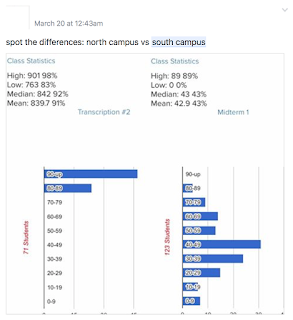Week 1 | Two Cultures
Within the UCLA community, there is a perception that humanities classes are “easier” than physical science classes. For this reason, an underlying tension exists between those pursuing degrees in the humanities and those pursuing degrees in the physical sciences. The geographic division of the two disciplines—North Campus (arts and humanities) and South Campus (math and physical sciences)—only magnifies this separation. Ironically, as a college student trying to find her place among these “Two Cultures” (Snow), I was unaware of how deeply rooted in our education system this divide between North Campus and South Campus is until thinking of them as two distinct "cultures".
Although C.P. Snow delivered his famous lecture over 50 years ago, his ideas are still relevant. He noted: “the politeness [between scientists and non-scientists] has gone, and they just make faces [at each other]” (Snow 19). The Sokal controversy (Vesna 123) exemplified this hostility between the two groups. Today, a similar rivalry between North Campus and South Campus majors at UCLA continues online in the form of internet memes.
 |
| Examples of memes taken from the UCLA Memes Facebook Page |
While these memes poke fun at this separation, their mere creation and existence is evidence that the Two Cultures remain just as divided as they were 50 years ago.
As a biochemistry major, I rarely ponder the philosophy of science. Most of the ideas introduced this week are new to me. However, I realized I
learned about Kuhn, mentioned in Professor Vesna's article, in one of the first classes I took at UCLA: Chemistry 20A with Eric Scerri. Little did I know, that Scerri's disagreement with Kuhn's ideas of scientific revolutions stems from works Vesna describes as "deepening the divide between the Two Cultures" (Vesna 123).
 |
| My old chemistry professor's newest book |
Making this connection was a recognition of the Two Cultures in my own life. I also stumbled upon Scerri's book, A Tale of Seven Scientists. He discusses how scientists are not driven by some external truth, but rather are driven from within, similar to Bohm’s idea that scientists are driven by the desire to create (Bohm 138). According to Bohm, this "need to discover and create something new" (138) is what unifies artists and scientists. I agree with Bohm. I foresee a Third Culture of artists that will bridge the gap between scientists and non-scientists. As for myself, I will be more conscious of the relationships between art, the humanities, and science as I pursue my own degree in Biochemistry.
Blakemore, Erin. “Take in the Beauty of Science with This Year’s
Wellcome Image Award
Winners.” Smithsonian.com. http://www.smithsonianmag.com/smart-news/take-beauty-science-years-wellcome-image-awards-winners-180958302/
9 Apr 2017.
Bohm, D. “On Creativity”. Leonardo 1.2 (Apr. 1968):137-149. Web.
Scerri, Eric. “A new philosophy of science? Surely that’s been outlawed” Oxford University
Press. Oxford University Press. 2 Nov. 2016. Web. 6 Apr. 2017.
Snow, C. P. “Two Cultures and the Scientific Revolution.” New
York: Cambridge UP, 1959.
Print.
Vesna, Victoria. “Toward a Third Culture: Being in
Between.” Leonardo 34.2 (2001): 121-25.
Web.



I was aware that UCLA's campus was separated based on majors, but like you I was not aware of how deeply ingrained it is in our educational system. I think it is great that while studying to earn your degree in biochemistry you will challenge yourself to be aware of the relationship and connection between art and science. Do you think this will be difficult for you to do, since most of the time you are studying science based material? I also agree with you that it is important to bridge the gap, as Bohm explianed in his ideas.
ReplyDeleteI agree with your claims regarding the tangible separation between the arts and science on our UCLA campus both geographically and within the student body. I liked how you included the memes from the Facebook page because I think it tied in well with the allusion to Snow's piece regarding how scientists and artists just "make faces" at one another. Both of these examples highlight the slight immaturity involved from both parties such that neither side is willing to bridge the gap and admit that, in fact, their fields overlap considerably and both sides could benefit from collaboration.
ReplyDeleteI would not go as far to agree with saying the north and south campus students "make faces" towards each other, but I agree with most of your points. There is a huge stigma that classes in north campus are easier. I am a north campus student and can not help but agree with this idea because if I were to take upper division biochemistry at UCLA, I would fail. I believe north campus and south campus students get along when off campus because the students do not see each other as students outside of campus.
Delete